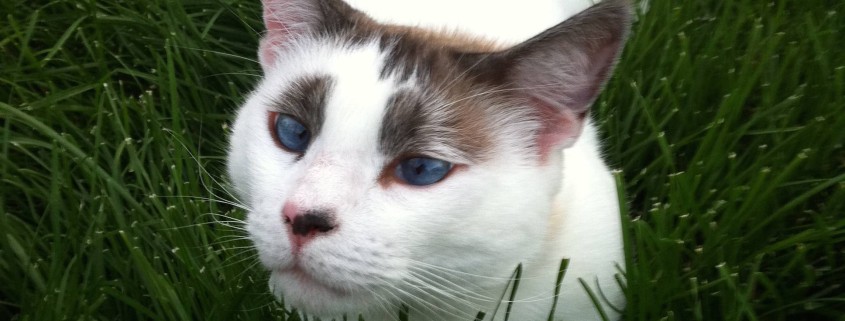
Keeping cats indoors has become our cultural norm only in the last 20 years, and as a result of this, cats are living longer. However, it is not always the easiest decision, nor the right decision for every cat. The question that has always been in the back of my mind regarding outdoor cats is, “Does a longer life mean a fuller life?” I think the answer to that question likely depends on the cat and the living circumstances.
Benefits of the Indoors:
- Safety from cars, fights and injury from wildlife or dogs
- Longer life expectancy
- More domesticated- Many say that cats become more “domesticated” when kept indoors
- Protect wild birds
- Avoid risks from poisons and toxins
Benefits of the Outdoors:
- Reduced behavioral issues like unwanted scratching and urination
- Reduced aggression towards humans and other household pets
- Reduced emotional stress due to environmental stimuli
- “Barn” and “working” cats help keep rodent populations down
Keeping cats indoors is by far the most common sentiment regarding the responsibilities of cat guardianship. Life expectancies have greatly increased because of the reduced risks of traffic accidents, fighting, injury, and infection. A major consideration for keeping cats indoors is safety.
Attitudes about “outdoor vs. indoor” cats is influenced by our culture, both macro and micro. For instance our “national” attitude towards cats is to keep them indoors, whereas our “neighborhood” culture may be to allow them outdoors.
Confining a cat to the indoors can guarantee their safety, but it also restricts their natural instincts to hunt, mark their territory, and explore. As a result of this confinement we see more behavioral problems with indoor cats than with outdoor cats.
It is my personal opinion that not all cats are well suited for indoor life. Those cats that are not well suited for the indoors will find other undesirable ways to express their biological needs, such as aggression towards others, spraying, scratching, and inappropriate urination/defecation.
We all know that an indoor cat will likely have a longer life, but I don’t believe this necessarily means a fuller life. We tend to project our own desires on to our animals, and I am no different. I look at my cats and when I think about that choice they would make for themselves, I feel that they would take the risk because I can’t imagine living my life solely indoors. I crave the outdoors and it’s an essential part of living a balanced life.
So here’s how I will break it down: For those who choose to keep their cats indoors I will provide a list of ways to keep your cats well balanced and happy. And for those who choose to let their cats outdoors I will provide a list of ways to keep your cats safe.
Keeping Indoor Cats HAPPY!
- PLAY! Play is so important for allowing your cat to express their natural instincts to hunt and explore. Interactive toys such as laser pointers, “chaser” poles, and treat dispensing toys provide both physical and mental stimuli.
- Scratching posts allow your cat to “mark their territory.” Provide different types of scratching options, i.e. sisal, corrugated cardboard, and cat trees made from real wood and place them in several different areas of your house.
- Provide options to climb, jump, and perch. Cat trees, shelves, and window perches give your cat the ability to exercise and give them a safe zone to observe their environment.
- Playmate: Companion animals can provide social interaction that can be beneficial as long as the animals are provided with enough space and resources and their personalities are well suited for one another.
- Treasure hunt- When you are at work or gone for extended periods of time, think about hiding treats around the house. This is a fun game that will engage your cat both mentally and physically.
Keeping Outdoor Cats SAFE!
- Cat enclosures and cat-proof fencing- enclose a window or porch. Cat proof your yard with angled fence attachments that prevent your cat from jumping out of your yard. Check out www.CatMan-Do.com and www.EasyPetFence.com
- Take your cat for a walk! Cat harnesses can be a super fun way to spend time with your cat and give your cat a safe way to access the outdoors. Remember the key to success is to let your cat walk you!
- Outdoor time should be permitted during daylight hours only, and only when you are home to supervise.
- Make sure your cat is healthy and up-to-date on vaccinations.
- Train your cat to come when you call them…. yes, it’s possible!
In summary, I think it’s important to understand the needs of your cat on an individual level and to provide for those needs accordingly. Not every situation is black and white. Use your own best judgement and make the decision that’s right for your cat.
I used to hate taking Pi for walks. She pulled. She growled at strangers. She went crazy every time she saw a rabbit. But now we walk happily all over town. 15-minute walks easily turn into two-hour long adventures. We have discovered beautiful open spaces, interesting old houses and smelly things for Pi to roll in. Pi is a calmer, happier dog and I’m a cheerier, more relaxed person when we make a point to walk every day!
Turns out, there’s science behind this. Dogs and wolves come from a common ancestor – one that foraged for food, covering miles of territory every day. Today, our canine companions don’t have to go searching for food (that’s what they have us for!)- but walks help satisfy other basic needs. Sniffing out other animal smells and encountering new things in their environment provide great brain stimulation. Even a ten-minute walk can help mentally-exercise your dog! (Just like ten minutes of doing tough math or word problems can help exercise our brains.)
Walking is good for us too. A study done at the California State University- Long Beach, showed that walking benefits humans in more ways than just the physical exercise. The study followed 37 subjects over a 20-day period. Professor Robert Thayer, leader of the study noted, “We found that there was a clear and strong relationship between the number of steps [participants] took and their overall mood and energy level,” (If you want to read more about that study, click here: http://www.csulb.edu/misc/inside/archives/vol_58_no_4/1.htm)
It took some time, patience, and a lot of training treats to get Pi to walk nicely on a leash, but the effort was totally worth it! I recommend using a training tool so you have a little more control over your dog if they get distracted. I used a Easy Walk Harness and a Halti head collar when I was training Pi to walk nicely. I still pull them out when we go to a new trail or exciting environment where she might “forget” her leash manners.
Walking Pi in the morning also allows me time to gather my thoughts before starting my workday, and walking her in the evenings helps me to unwind and review the day. Pi’s always happy to get out and see who’s peed on each fire hydrant since she smelled it last. If walking isn’t part of your routine yet, take your dog for a 5-10 minute walk around your block. I’m willing to bet you’ll both have some fun. If you and your dog are already getting out for regular walks, we want to hear about that too! Tell us where your favorite route is!
Here are four ways for us to change an animal’s life for the better this year (Which will ultimately make our lives better too!)
Adopt
The motivation behind Change a Pet’s Life Day is to help animals in shelters and rescue groups find their forever homes. PetFinder.com is an awesome site that lets you search for animals by breed, size and age or you can browse through all the dogs and cats in your area. You can find puppies and kittens or older animals who already have some training. Providing a great home for an animal in need is the ultimate way to change their life!
Foster
If you’re not ready to commit to keeping an animal for the rest of his life, consider fostering! Most rescue groups are based solely in fosters homes and many shelters rely on fosters for animals who are stressed by the shelter situation. Dogs in foster homes tend to find their forever family faster than ones in shelters because they’re out and about meeting friends and neighbors! (Be warned: many foster families “fail” the process and end up adopting their foster pup! It’s a happy accident!)
Volunteer
We’ve made a friend at The Happy Beast who volunteers for the Colorado Rabbit House Society in Broomfield- a rescue devoted entirely to bunnies! She told me they are always looking for volunteers to feed the rabbits, clean the cages and to take care of daily chores. How fun would it be to spend an afternoon with a whole bunch of rabbits??
Check out volunteermatch.org to find opportunities to volunteer with animals in your area. We can put you in touch with our favorite rescue groups too!
Exercise & Train
Behavioral problems are the most common reasons given when people drop their animals off at a shelter. While most of us can’t imagine giving up our pets, providing them with a balanced and active home can make sure we’re never faced with that dilemma! Make sure your pets get plenty of mental and physical exercise. Play with your cats and give them a variety of toys. Walk your dog, take him on hikes and teach him new tricks.
Alright, now get out there and change some lives!
Sticking to resolutions can be hard, but everything’s easier with a buddy. This year, let’s make New Year’s resolutions for you and your dog! Here are three easy ideas for you and your pup to do together.
- Exercise
You don’t have to join a gym or start training for a marathon. To get started, take your dog for a walk around the block. Getting out for a ten minute walk promotes healthy blood flow, allows you to soak up Vitamin D from the sun and helps boost your mood, altogether protecting his you from stress and disease. Your dog will benefit from the mental stimulation provided by the ever-changing smells in the environment and the relationship-building power of leashed walking. (Read more here!)
- Eat Fresh Food
YOU: Grab a salad for lunch or replace your afternoon sugar snack with an apple.YOUR DOG: Add a little life to your dog’s food! Dogs fed mostly kibble miss out on all the awesome nutrients and enzymes found in fresh foods. Adding a dehydrated food like Sojos or The Honest Kitchen is an easy way to provide the benefits of home cooking without having to do all the work. - Take a Fish Oil Supplement
Omega 3s reduce inflammation, joint pain and promote healthy skin, fur and hair! This one’s easy. Keep your dog’s fish oil next to yours, and when you take two, he takes one (or two if he’s a big guy.) I’ve been giving my dog the awesome Omega 3 supplement from InClover called Glow. She LOVES these little treats, and reminds me to give her one every day.
Happy New Year’s to all you happy beasts and good luck with those resolutions!
CONTACT US
HOURS
Mon – Fri: 10am – 7pm
Sat: 9am – 6pm
Sun: 10am – 5pm
© The Happy Beast
LOCATION
1230 Etna Dr.
Lafayette, CO 80026
(Get Directions)
Located just off South Boulder Rd. behind Elevations Credit Union and Stan’s Automotive. You can turn onto either Etna or Cimarron and look for the dark blue building.




